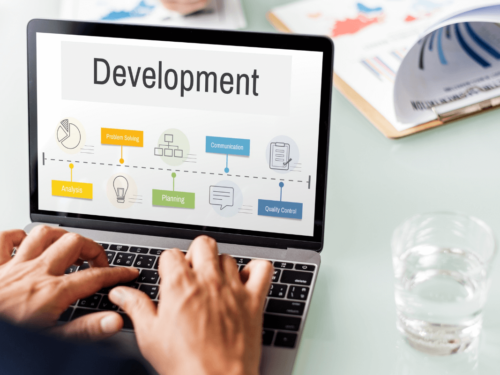
In the competitive world of digital marketing, your agency’s website is one of your most powerful tools for driving business. However, simply having a website isn’t enough. It needs to be optimized specifically for lead generation. This means transforming your website into a lead-generating machine that not only attracts visitors but also converts them into clients.
How to Create a Lead Generation Website
Creating a website designed for lead generation requires careful planning and attention to the user journey. Here are the key steps to building a website that turns visitors into leads:
- Design for Conversion: Your website should be designed with conversion in mind. Focus on creating an intuitive user experience, easy navigation, and clear CTAs that lead visitors to take action.
- Create Compelling Content: Offer value through blogs, case studies, whitepapers, and other resources that solve your visitors’ problems.
- Optimize Forms: Keep lead capture forms short and simple, asking for only essential information to avoid friction in the conversion process.
- Use Targeted Offers: Ensure that each page on your website has a specific lead generation offer that matches the content your visitors are viewing.
How to Increase Leads on Your Website
To increase leads on your website, you need to continuously refine your strategy and ensure that each element of your site is optimized for conversions. Here are a few key strategies to implement:
- A/B Test Your CTAs: Test different CTA styles, colors, and placements to see what resonates best with your audience.
- Create High-Converting Landing Pages: Continuously tweak your landing pages to ensure they are converting at the highest rate possible. Test headlines, images, copy, and form fields to maximize conversion.
- Leverage Retargeting Ads: Use retargeting ads to bring back visitors who didn’t convert the first time. These ads will remind them of your offer and encourage them to return.
- Offer Lead Magnets: Provide valuable content or resources in exchange for your visitors’ contact information. This encourages them to engage with your business and move down the sales funnel.

Best Practices For Optimizing Your Website To Maximize Lead Generation
1. Clear and Compelling Call to Actions (CTAs)
A call-to-action (CTA) is the key to turning website visitors into leads. Your CTAs should be strategically placed across your site, compelling visitors to take action. Make sure your CTAs are simple and action-oriented, telling visitors exactly what you want them to do next. Some effective examples include “Get a Free Consultation,” “Download Our Guide,” or “Contact Us Today.”
Best Practices for Effective CTAs:
- Use contrasting colors to make your CTAs stand out.
- Position them at the top of the page, in the middle of blog posts, and at the bottom of service pages.
- Use clear, action-driven language like “Start Your Project Now” or “Claim Your Free Trial.”
2. Optimize Your Landing Pages
Landing pages are your opportunity to capture leads. These pages should be laser-focused on a specific offer, whether it’s a free consultation, an ebook, or a webinar registration. Every element of your landing page should work towards guiding the visitor to take action.
Key Elements of an Optimized Landing Page:
- Headline: Should clearly state what the visitor will gain by completing the action.
- Compelling Copy: Keep it brief, focusing on the benefits your offer provides.
- Form Fields: Limit the number of fields in your form to make it easy for visitors to sign up.
- Trust Signals: Include testimonials, certifications, or client logos to build credibility.
3. High-Quality Content to Build Trust
Content is not only a tool for educating your audience but also for building trust. Providing valuable resources like blog posts, case studies, videos, or eBooks allows you to showcase your expertise and nurture leads. These resources should solve the problems your target audience faces, positioning your agency as the solution.
Types of Content to Consider:
- Case Studies: Showcasing real-world examples of your success stories.
- Blog Posts: Addressing common challenges and providing actionable tips.
- Videos and Webinars: Offering in-depth discussions on industry trends or demonstrating your agency’s expertise.
4. Lead Magnets: Offering Value to Capture Leads
Lead magnets are essential for attracting and capturing visitor information. These could be free trials, checklists, guides, templates, or industry reports. The goal is to offer something valuable in exchange for their contact details. This builds trust and allows you to follow up with targeted messaging.
Best Practices for Lead Magnets:
- Ensure your lead magnet aligns with the needs of your target audience.
- Promote it prominently on your homepage, blog, and landing pages.
- Make sure it’s high-quality and genuinely helpful to your visitors.
5. Mobile Optimization: A Must for Lead Generation
With mobile traffic continuing to rise, having a mobile-optimized website is no longer optional—it’s essential. If your site isn’t optimized for mobile users, you risk losing a large portion of potential leads. Mobile optimization ensures your visitors have a smooth, hassle-free experience no matter what device they use.
To make your website mobile-friendly, consider the following:
- Responsive Design: Your website should adjust to any screen size automatically.
- Fast Loading Speed: Mobile users expect a fast experience. Slow-loading pages are one of the main reasons users bounce.
- Touch-Friendly Navigation: Make sure buttons and forms are easy to click on mobile devices.
For more details on how to optimize your website for mobile, check out our comprehensive guide on how to optimize your website for mobile. Additionally, ensure that your site is ready for mobile search by learning about mobile-first indexing and optimizing your site for mobile search.
6. Speed Matters: Enhance Your Website’s Load Time
Website load time plays a critical role in user experience and lead conversion. A delay of even a few seconds can result in lost leads. Slow-loading pages not only frustrate visitors but can also negatively impact your SEO rankings.
Tips to Improve Load Speed:
- Compress images to reduce file sizes.
- Limit the number of third-party scripts and plugins.
- Use caching and content delivery networks (CDNs) to speed up load times.
7. SEO: The Key to Attracting Organic Traffic
Without proper SEO, your website won’t attract the right visitors. Search engine optimization helps ensure your website ranks high on search engines for the relevant keywords and phrases your potential clients are searching for.
On-Page SEO Strategies:
- Keyword Optimization: Research and integrate relevant keywords into your content.
- Mobile Optimization: As mentioned earlier, mobile optimization is crucial for SEO.
- Content Quality: Create high-quality, relevant content that addresses the needs of your target audience.
8. Chatbots for Instant Engagement
Chatbots are becoming an invaluable tool for lead generation. These AI-powered assistants help engage website visitors in real time, providing instant responses to questions and guiding them through the conversion process. Chatbots can also collect valuable lead information, qualifying visitors as they interact.
Benefits of Chatbots:
- They help capture leads immediately by engaging visitors when they land on your site.
- They can answer frequently asked questions and guide visitors to relevant information.
- They offer personalized recommendations based on user interactions.
9. Tracking and Analyzing Lead Generation Performance
To continuously improve your lead generation efforts, you must track and analyze performance regularly. Use tools like Google Analytics, heatmaps, and A/B testing to see how visitors interact with your website. This data will help you identify areas that need improvement and refine your lead generation strategies.
Key Metrics to Track:
- Conversion rate (how many visitors are turning into leads)
- Bounce rate (how quickly users leave your website)
- Time on page (how long visitors stay on key pages)
10. Social Proof and Testimonials: Building Trust
One of the most effective ways to persuade potential clients is through social proof. Display testimonials, reviews, and case studies prominently on your site. Visitors are more likely to trust your agency when they see real-world examples of your success.
How to Incorporate Social Proof:
- Feature client testimonials and success stories on your homepage and landing pages.
- Include logos of well-known clients or partners.
- Use industry certifications or awards to showcase your credibility.
Conclusion
Optimizing your website for lead generation is a crucial task that requires ongoing effort and strategy. By implementing best practices like clear CTAs, engaging content, responsive design, and strong SEO, your marketing agency can start generating high-quality leads that convert. Always track your performance, tweak your strategies, and refine your approach to ensure continued success in lead generation.
FAQs
1. What is lead generation, and why is it important for my marketing agency?
Lead generation is the process of attracting and converting potential clients into leads by capturing their contact information. For marketing agencies, it’s crucial as it helps you build a pipeline of prospective clients who are interested in your services, allowing for continuous business growth.
2. How can I make my website more effective for lead generation?
To optimize your website for lead generation, focus on having clear and compelling CTAs, high-quality content, mobile optimization, fast load times, and responsive design. Additionally, use lead magnets, landing pages, and social proof to build trust and capture leads effectively.
3. How do landing pages contribute to lead generation?
Landing pages are designed to focus on a specific offer and guide visitors toward a conversion goal, such as signing up for a consultation or downloading a resource. They help reduce distractions and increase the likelihood that visitors will take action, making them a critical component of lead generation.
4. Why is mobile optimization important for lead generation?
Mobile optimization ensures that your website is accessible and easy to use on mobile devices. With more people using smartphones to browse the web, a mobile-friendly site improves user experience, reduces bounce rates, and increases the chances of converting visitors into leads. Learn more about optimizing your site for mobile in our guide.
EvenDigit
EvenDigit is an award-winning Digital Marketing agency, a brand owned by Softude (formerly Systematix Infotech) – A CMMI Level 5 Company. Softude creates leading-edge digital transformation solutions to help domain-leading businesses and innovative startups deliver to excel.
We are a team of 70+ enthusiastic millennials who are experienced, result-driven, and hard-wired digital marketers, and that collectively makes us EvenDigit. Read More





